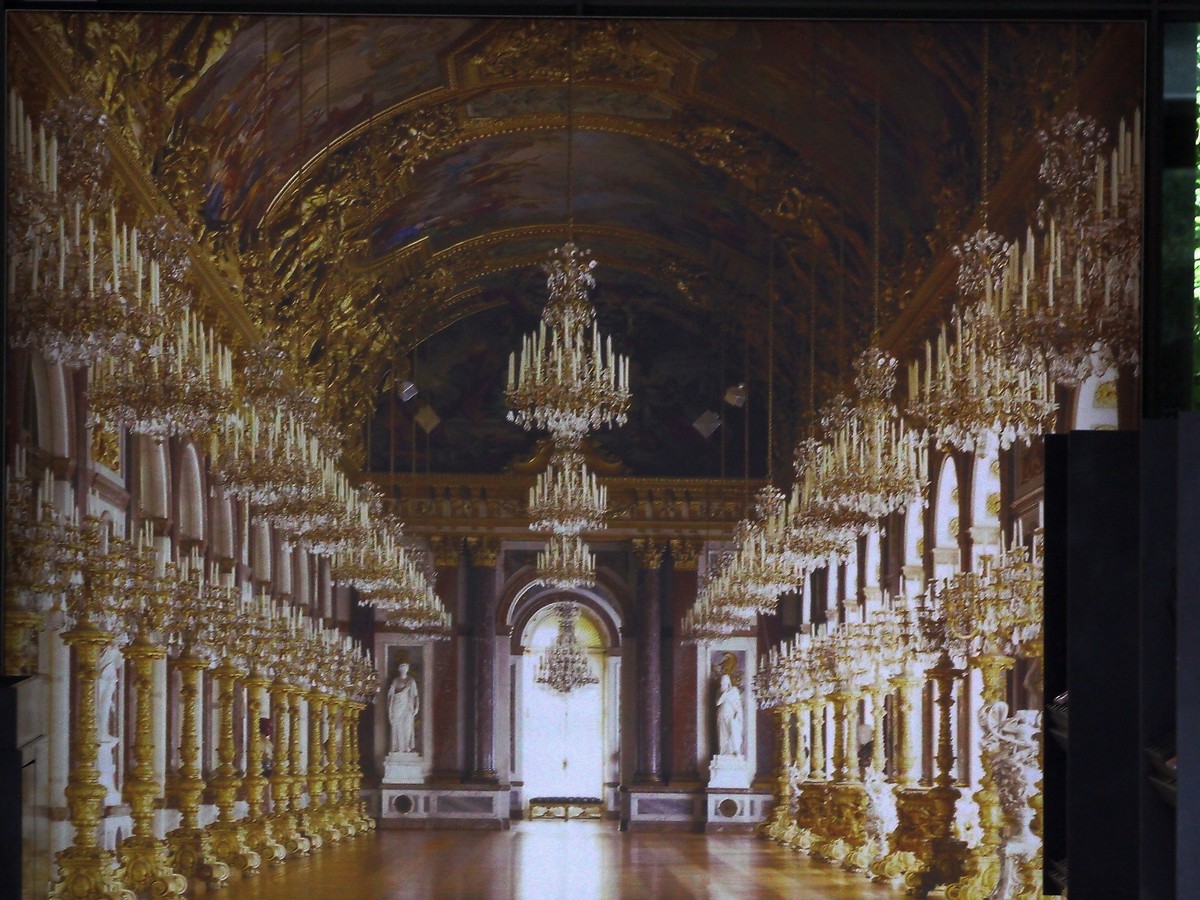Schloss Herrenchiemsee
"Fun, fun, fun on the Autobahn"
Actually, the lyrics to Kraftwerk's 1974 classic song are "Wir fahren, fahren, fahren auf der Autobahn", which translate as "We drive, drive, drive on the Autobahn", but it doesn't matter, as driving on Germany's famed highway is as the Beach Boys would've described it. Having our rented Opal for another day, we took a brief spin on the Autobahn from Munich to the Bavarian Sea (Chiemsee), a large lake a short drive from the center of the Bavarian capital. Short in that it only took an hour from our hotel when reaching speeds of up to 150 kph (93 mph), and still being passed by many other cars in the process. No wonder I like Germany...
The main attraction in Chiemsee is the castle Schloss Herrenchiemsee, a palace built by Ludwig II and most definitely inspired, both inside and out, by the Sun King (Louis XIV) and Versailles. It sits on an island 1.5 kilometers (0.9 miles) across the lake from the town of Priem am Chiemsee, from where we boarded a ferry after parking our car. The weather would be overcast virtually the entire time we were there (so much for any notions of going for a swim while in Germany), but the temperature stayed warm and it never rained, so any complaints we had were muted:
The palace is a 20-minute walk from the ferry landing, and seems to appear out of nowhere as you round a corner and reach the pretty garden. The building is pure Ludwig - a romantic fantasy brought to life while bringing the royal purse close to depletion. The money for its construction actually ran out in 1885, a year before Ludwig's tragic death, leaving 50 rooms unfinished. Those that were completed are simply astonishing:
The interior can only be glimpsed on guided tours (in English or German), and photography is forbidden, so the following highlights of the palace were gleaned from the Internet (Danke, Google). The first stop on the tour is the Gesandtentreppe (Ambassador Staircase):
Stunning though it was, the staircase is no comparison to the Grosse Spiegelgalerie (Great Hall of Mirrors), a tunnel of light that at 98 meters (322 feet) runs the length of the garden. The hall contains 52 candelabra and 33 great glass chandeliers with 7000 candles, which took 70 servants 30 minutes to light. On our visit the hall was lined with chairs set up in preparation for a classical concert. One (well, a plebe like me, anyway) can only imagine what it would be like to experience a performance in that environment:
Lonely Planet describes the Paradeschlafzimmer (State Bedroom) as "the heart of the palace" as morning and evening audiences were held in this room:
Then there is the king's bedroom, the Kleines Blaues Schlafzimmer (Little Blue Bedroom), decorated with gilded stucco and extravagant carvings. The room would be bathed in a soft blue light from a glass globe at the foot of the bed that took a technician 18 months to perfect:
Astonishly, Ludwig only spent ten days in total at Herrenchiemsee, and was rarely seen when he was present, as he preferred to read all night and sleep all day.
While pictures-taking is discouraged on the tour, it is allowed in the onsite König Ludwig II Musuem. The exhibits include the king's christening and coronation robes...:
...his death mask...:
and blueprints and scale models for other buildings that sprung from the king's wild imagination, such as his proposed theater for his friend Richard Wagner...:
...and the absolutely astounding Falkenstein Castle, which probably would've outshone Ludwig's celebrated Neuschwanstein (which we would visit the next day) had it ever actually had been built:
All that opulence works up an appetite, so we returned to the area by the jetty, and lunched on a bluff overlooking the lake. Returning to reality in Germany involved beer and wurst, of course:
From our table we could see our next destination, the island of Fraueninsel:
And so after lunch we caught another ferry for the short ride over to the island, home of Frauenwörth Abbey:
The abbey was founded in the late 8th-century, but is closed to casual visitors:
The adjoining church (10th-century), however, with its distinctive onion-dome top (11th century) is open to Joe Public (the gift shop is also worth a visit):
Opposite the museum is the Torhalle, a museum that houses religious items and sculptures, as well as changing exhibits focusing on the works of regional painters. According to LP, the building dates from the year 860 and is an example of Carolingian architecture:
Having noted that fact, I somehow neglected to take a photo of the museum from the outside while we were there. Google to the rescue, again:
I did get a shot of the abbey from the Torhalle, however:
Though the abbey is the main draw, the island itself is a pleasant destination of cafes and crafts shops and can be easily circumnavigated on foot - it's only 15.5 hectares (38 acres) in size, has a population of just 300 souls and is free of cars:
And with that, we returned to Prien by ferry and drove back on the Autobahn to Munich. Rush-hour traffic in the city turned what should've been another one-hour drive into a 2½-hour ordeal of narrow streets and bumper-to-bumper traffic. Driving on the German motorway was a fantastic experience, but it was with a great deal of relief when we dropped the car off at the rental agency and returned on foot from the Hauptbahnhof back to our hotel. Still, it was fun, fun, fun while drive, drive, drive on the Autobahn:





























No comments:
Post a Comment